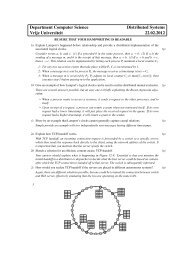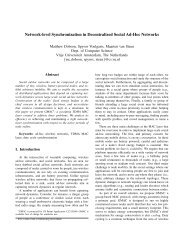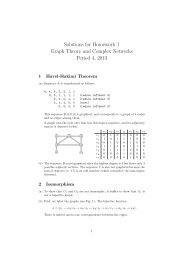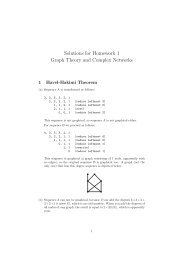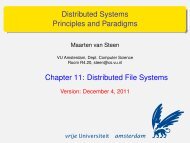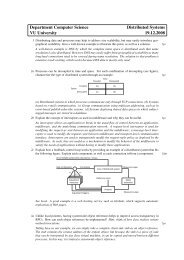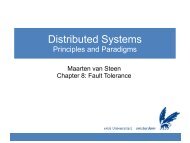Distributed Coordination-Based Systems - Maarten van Steen
Distributed Coordination-Based Systems - Maarten van Steen
Distributed Coordination-Based Systems - Maarten van Steen
Create successful ePaper yourself
Turn your PDF publications into a flip-book with our unique Google optimized e-Paper software.
<strong>Distributed</strong> <strong>Systems</strong><br />
Principles and Paradigms<br />
<strong>Maarten</strong> <strong>van</strong> <strong>Steen</strong><br />
VU Amsterdam, Dept. Computer Science<br />
Room R4.20, steen@cs.vu.nl<br />
Chapter 13: <strong>Distributed</strong> <strong>Coordination</strong>-<strong>Based</strong><br />
<strong>Systems</strong><br />
Version: December 4, 2011
2 / 14<br />
Contents<br />
Chapter<br />
01: Introduction<br />
02: Architectures<br />
03: Processes<br />
04: Communication<br />
05: Naming<br />
06: Synchronization<br />
07: Consistency & Replication<br />
08: Fault Tolerance<br />
09: Security<br />
10: <strong>Distributed</strong> Object-<strong>Based</strong> <strong>Systems</strong><br />
11: <strong>Distributed</strong> File <strong>Systems</strong><br />
12: <strong>Distributed</strong> Web-<strong>Based</strong> <strong>Systems</strong><br />
13: <strong>Distributed</strong> <strong>Coordination</strong>-<strong>Based</strong> <strong>Systems</strong>
<strong>Coordination</strong>-<strong>Based</strong> <strong>Systems</strong><br />
13.1 <strong>Coordination</strong> Models<br />
<strong>Coordination</strong> models<br />
Essence<br />
We are trying to separate computation from coordination; coordination<br />
deals with all aspects of communication between processes, as well as<br />
their cooperation.<br />
Couplings<br />
Make a distinction between<br />
Temporal coupling: Are cooperating/communicating processes<br />
alive at the same time?<br />
Referential coupling: Do cooperating/communicating processes<br />
know each other explicitly?<br />
3 / 14
<strong>Coordination</strong>-<strong>Based</strong> <strong>Systems</strong><br />
13.1 <strong>Coordination</strong> Models<br />
<strong>Coordination</strong> models<br />
Temporal<br />
Coupled Decoupled<br />
Referential<br />
Coupled<br />
Decoupled<br />
Direct<br />
Meeting<br />
oriented<br />
Mailbox<br />
Generative<br />
communication<br />
4 / 14
<strong>Coordination</strong>-<strong>Based</strong> <strong>Systems</strong><br />
13.2 Architectures<br />
5 / 14<br />
Architectures: Overview<br />
Essence<br />
A data item is described by means of attributes.<br />
When made available, it is said to be published.<br />
A process interested in reading an item, must provide a subscription: a<br />
description of the items it wants.<br />
Middleware must match published items and subscriptions.<br />
Publisher<br />
Subscriber<br />
Subscriber<br />
Data item<br />
Subscription<br />
Read/Delivery<br />
Notification<br />
Publish/subscribe middleware<br />
Match
<strong>Coordination</strong>-<strong>Based</strong> <strong>Systems</strong><br />
13.2 Architectures<br />
Example: Jini/Javaspaces<br />
<strong>Coordination</strong> model<br />
Temporal and referential uncoupling by means of JavaSpaces, a<br />
tuple-based storage system.<br />
A tuple is a typed set of references to objects<br />
Tuples are stored in serialized, that is, marshaled form into a<br />
JavaSpace<br />
To read a tuple, construct a template, with some fields left open<br />
Match a template against a tuple through a field-by-field<br />
comparison<br />
6 / 14
7 / 14<br />
<strong>Coordination</strong>-<strong>Based</strong> <strong>Systems</strong><br />
Example: Jini/Javaspaces<br />
13.2 Architectures<br />
A Write A B Write B T Read T<br />
C<br />
Insert a<br />
copy of A<br />
Insert a<br />
copy of B<br />
Look for<br />
tuple that<br />
matches T<br />
Tuple instance<br />
A<br />
B<br />
B<br />
B<br />
A<br />
C<br />
Return C<br />
(and optionally<br />
remove it)<br />
A JavaSpace<br />
Write: A copy of a tuple (tuple instance) is stored in a JavaSpace<br />
Read: A template is compared to tuple instances; the first match returns a<br />
tuple instance<br />
Take: A template is compared to tuple instances; the first match returns a<br />
tuple instance and removes the matching instance from the JavaSpace
<strong>Coordination</strong>-<strong>Based</strong> <strong>Systems</strong><br />
13.2 Architectures<br />
8 / 14<br />
Example: TIB/Rendezvous<br />
<strong>Coordination</strong> model<br />
Uses of subject-based addressing ⇒ publish-subscribe system.<br />
Receiving a message on subject X is possible only if the receiver had<br />
subscribed to X<br />
Publishing a message on subject X ⇒ message is sent to all (currently<br />
running) subscribers to X.<br />
Publ. on A<br />
Subs. to A<br />
Subs. to A<br />
Publ. on B<br />
Subs. to A<br />
Subs. to B<br />
Subs. to B<br />
Subj: A<br />
Subj: B<br />
RV lib<br />
RV lib<br />
RV lib<br />
RV lib<br />
RV lib<br />
RV<br />
daemon<br />
RV<br />
daemon<br />
RV<br />
daemon<br />
RV<br />
daemon<br />
RV<br />
daemon<br />
Multicast message<br />
on A to subscribers<br />
Multicast message on B to subscribers<br />
Network
<strong>Coordination</strong>-<strong>Based</strong> <strong>Systems</strong><br />
13.2 Architectures<br />
9 / 14<br />
Example: Lime<br />
Lime<br />
Every node has its own dataspace:<br />
When P and Q are in each other’s proximity, dataspaces become shared<br />
Published data items are stored locally, until removed<br />
P can publish data items from specific process<br />
Reactions describe what to do when a match is found<br />
Transient, shared dataspace<br />
Process<br />
Process<br />
Process<br />
Local<br />
dataspace<br />
Local<br />
dataspace<br />
Local<br />
dataspace<br />
Wireless link
<strong>Coordination</strong>-<strong>Based</strong> <strong>Systems</strong><br />
13.4 Communication<br />
Content-based routing<br />
Observation<br />
When a coordination-based system is built across a wide-area<br />
network, we need an efficient routing mechanism (centralized solutions<br />
won’t do).<br />
Solution<br />
Naive: Broadcast subscriptions to all nodes in the system and let<br />
servers prepend destination address when data item is published<br />
Refinement: Forward subscriptions to all routers and let them<br />
compute and install filters.<br />
10 / 14
11 / 14<br />
<strong>Coordination</strong>-<strong>Based</strong> <strong>Systems</strong><br />
13.4 Communication<br />
Content-based routing: naive solution<br />
1<br />
5<br />
3 1 R1<br />
1<br />
2<br />
3<br />
R2<br />
3<br />
4<br />
3
<strong>Coordination</strong>-<strong>Based</strong> <strong>Systems</strong><br />
13.7 Consistency and Replication<br />
12 / 14<br />
Replication: Static approaches<br />
Note<br />
Replicating data items to all machines implies broadcasting removals.<br />
Tuple broadcast<br />
Process doing<br />
a write broadcasts<br />
Network<br />
(a)<br />
Process doing a take<br />
examines local JavaSpace<br />
Tuple delete<br />
Subspaces<br />
Network<br />
(b)
<strong>Coordination</strong>-<strong>Based</strong> <strong>Systems</strong><br />
13.7 Consistency and Replication<br />
Balancing read/write operations<br />
Problem<br />
Find a balance between the costs for reads, and writes/removals ⇒ organize<br />
dataspace as 2D grid<br />
Example<br />
A<br />
C<br />
A broadcasts<br />
tuple to these<br />
machines<br />
A writes a data<br />
item;<br />
B wants to<br />
read it.<br />
B<br />
B broadcasts template<br />
to these machines<br />
13 / 14
14 / 14<br />
Dynamic replication<br />
<strong>Coordination</strong>-<strong>Based</strong> <strong>Systems</strong><br />
13.7 Consistency and Replication<br />
Observation: Not all data items are equal<br />
Decide on replication on a per-type basis<br />
Refinement: Let a central component observe read/write patterns and<br />
decide on replication strategy (self-replication)<br />
Application<br />
Dataspace<br />
slice<br />
Distribution<br />
Distribution<br />
manager Distribution<br />
manager<br />
manager<br />
Invocation<br />
handler<br />
Policy<br />
table<br />
Local OS<br />
To network




